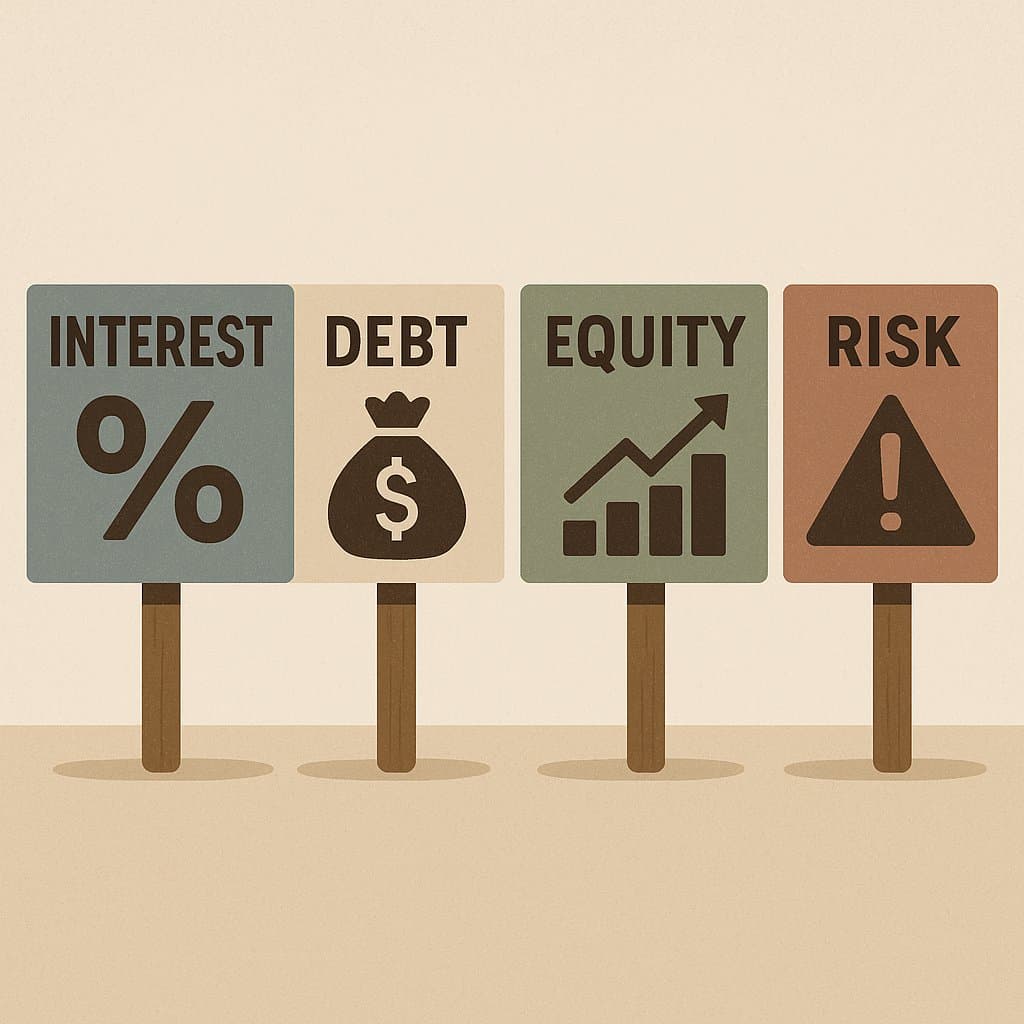Mastering Equity, Debt, Interest, and Risk: Essential Finance Insights for 2025
Unlock the core finance concepts of equity, debt, interest, and risk to confidently navigate 2025’s evolving investment landscape. Discover actionable insights and debunk myths for beginner investors.

Key Takeaways
- Equity equals ownership value after debts are paid
- Debt financing avoids ownership dilution but requires interest payments
- Interest can grow investments exponentially via compounding
- Risk varies by asset class and demands diversification
- Private equity and alternative investments offer new 2025 opportunities

Diving into investing can feel like decoding a secret language—terms like equity, debt, interest, and risk swirl around like financial jargon storms. But understanding these pillars is your compass for 2025’s shifting markets. Equity isn’t just a buzzword; it’s your ownership stake, the real measure of what you hold after debts are settled. Debt, meanwhile, is the borrowed fuel that companies use to grow, but it comes with strings attached—interest. And risk? It’s the shadow that follows every investment, reminding us that rewards and losses dance closely. This guide unpacks these essentials, weaving in fresh insights on private equity and alternative investments reshaping the landscape. Ready to cut through the noise and invest with clarity? Let’s get started.
Decoding Interest and Its Power
Interest is the heartbeat of finance—sometimes a friend, sometimes a foe. Imagine lending money and watching it grow, not just on the original amount but on the interest it earns too. That’s compound interest, the magic behind exponential growth. Simple interest, by contrast, only rewards you on your initial stake. For investors, interest income from bonds or savings accounts can feel like a steady drip of passive cash. But beware: interest rates don’t stand still. When rates climb, bond prices often fall, a seesaw that can rattle your portfolio. Managing this interest rate risk means diversifying bond maturities and choosing quality issuers. It’s not just about chasing yields—it’s about understanding the dance between rates and prices to keep your investments humming smoothly.
Unpacking Debt: The Double-Edged Sword
Debt is the financial fuel companies use to power growth, but it’s a double-edged sword. Borrowing money means promising to pay it back with interest, a commitment that can strain a company if cash flows falter. For investors, buying corporate or government bonds is like lending money with a promise of steady interest payments—usually safer than stocks but with lower upside. The catch? Credit risk—the chance the borrower defaults. High debt levels can tip a company into financial stress, making equity holders nervous since they’re last in line if things go south. Yet, debt financing has a charm: it doesn’t dilute ownership like selling shares does. Understanding this balance helps investors weigh safety against growth potential in their portfolios.
Grasping Equity: Ownership and Opportunity
Equity is more than a number on a balance sheet—it’s your claim to a company’s future. Calculated as total assets minus liabilities, shareholders’ equity reveals what’s left if a company sold everything and paid all debts. Positive equity signals financial health; negative equity rings alarm bells. Owning stock means you’re part-owner, with rights to profits and votes on corporate decisions. But with ownership comes risk—shareholders are last to get paid if a company liquidates. Equity isn’t just public stocks; it includes private equity, home equity, and even brand equity—the intangible value of a company’s reputation. For beginners, understanding equity’s many faces unlocks doors to diverse investment paths and growth opportunities.
Navigating Risk: The Investment Balancing Act
Risk is the shadow lurking behind every investment promise. It’s the chance that your money might shrink instead of grow. Different assets carry different risks: stocks face market swings, bonds wrestle with interest rate and credit risks, and some investments struggle with liquidity—selling quickly without losses. Company-specific risks can hit equity holders hard if a firm stumbles. The golden rule? Higher returns usually come with higher risks. Stocks offer growth but can be volatile; bonds provide steadier income but lower gains. For beginners, building a balanced portfolio means spreading investments across asset classes and sectors, using tools like index funds and bond ladders to soften shocks. Regular portfolio checkups keep your risk aligned with your goals, turning uncertainty into opportunity.
Exploring Alternative Investments in 2025
As traditional stocks and bonds face headwinds, alternative investments are stepping into the spotlight in 2025. Think real estate development fueled by a U.S. housing shortage, or energy infrastructure booming thanks to AI-driven demand. Private equity dealmaking is rebounding amid easing interest rates and deregulation, opening doors for savvy investors. Capital investment is surging to back innovation, with growth equity and venture capital fueling tech breakthroughs. Private credit also shines, offering attractive yields in a higher-rate environment. These alternatives add layers of diversification and fresh growth avenues but come with unique risks and require careful due diligence. For investors ready to expand beyond the usual suspects, 2025’s alternative themes offer a compelling narrative of opportunity and challenge.
Long Story Short
Grasping equity, debt, interest, and risk isn’t just academic—it’s the foundation for steering your financial ship through 2025’s unpredictable seas. Equity offers a stake in growth but demands courage against volatility. Debt provides steadier income streams but requires vigilance around interest and credit risks. Interest, especially compounding, can be your secret weapon or your foe if misunderstood. Risk, the ever-present companion, calls for smart diversification and ongoing portfolio tuning. As private equity and alternative investments rise, so do new avenues—and new challenges. The key? Stay curious, question assumptions, and align your choices with your unique financial story. With these tools, you’re not just investing—you’re crafting your future with confidence and savvy.